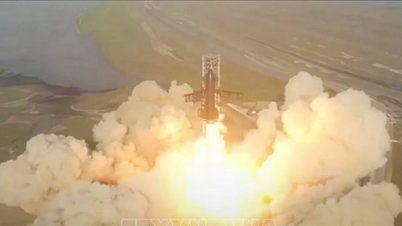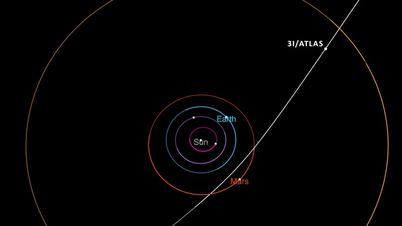SpaceX's powerful Starship rocket system tested multiple maneuvers in orbit for the first time in an hour but was unable to land safely.
The third test flight of the Starship rocket. Video : WSJ
SpaceX's giant Starship rocket reached orbit for the first time but was destroyed during reentry, according to Space . The largest and most powerful rocket ever built took off from the launch pad in Boca Chica, Texas at 9:25 a.m. local time on March 14 (8:25 p.m. on May 14, Hanoi time), entering the stratosphere just minutes later with a record 7.5 million kg of thrust. At 120 m tall, Starship can carry 10 times more cargo than SpaceX's current Falcon 9 rocket.
This was the rocket’s third test flight and its first launch into orbit. The previous two launches ended with explosions of the 33-engine Super Heavy booster. After Starship performed a series of maneuvers during its hour-long orbital flight (including re-firing its engines and opening its cargo bay doors), mission control reported losing contact with Starlink, SpaceX’s satellite internet service, and the Tracking and Datalink Satellite System they use to monitor the rocket. SpaceX confirmed that Starship likely broke up or exploded over the Indian Ocean.
Although the Starship’s upper stage failed to land at sea as planned, its cameras remained active during reentry. The upper stage reached a maximum orbital speed and altitude of 234 kilometers, according to telemetry data provided by SpaceX. Starship sent back stunning images from that altitude, including puffy white clouds floating over the ocean and the curve of the Earth against the black background of space. About 46 minutes after launch, Starship descended to an altitude of 100 kilometers. Cameras on Starship captured orange streaks of flame erupting from the vehicle’s fins and belly. Seconds later, they turned into walls of superheated plasma as Starship flew lower and lower, experiencing temperatures of up to 1,430 degrees Celsius.
Transmitting data through such a hot plasma field is difficult. But Starship made it through, using SpaceX’s Starlink internet satellites to communicate with controllers on the ground. Starship continued to send visual data until 48.5 minutes after launch, when it descended to an altitude of 77 kilometers. Then all data stopped abruptly, suggesting that Starship likely broke apart due to friction.
SpaceX plans to use future versions of Starship to transport astronauts, spacecraft, satellites, and cargo to various locations in the solar system. NASA plans to use Starship’s Human Lander System to return astronauts to the lunar surface for the first time since 1972, during the Artemis 3 and 4 missions. Starship is designed to be cheap and efficient to manufacture, using inexpensive stainless steel and methane fuel. The vehicle is designed to be reusable and carry up to 275 tons of cargo.
The first two Starship test flights, in April 2023 and November 2023, lasted just four and eight minutes, respectively. SpaceX has built four more Starship rockets to perfect the vehicle through testing. According to SpaceX, failures in the initial testing phase are normal.
An Khang (According to Live Science )
Source link




![[Photo] Lam Dong: Panoramic view of Lien Khuong waterfall rolling like never before](/_next/image?url=https%3A%2F%2Fvphoto.vietnam.vn%2Fthumb%2F1200x675%2Fvietnam%2Fresource%2FIMAGE%2F2025%2F11%2F20%2F1763633331783_lk7-jpg.webp&w=3840&q=75)
![[Photo] National Assembly Chairman Tran Thanh Man holds talks with South Korean National Assembly Chairman Woo Won Shik](/_next/image?url=https%3A%2F%2Fvphoto.vietnam.vn%2Fthumb%2F1200x675%2Fvietnam%2Fresource%2FIMAGE%2F2025%2F11%2F20%2F1763629724919_hq-5175-jpg.webp&w=3840&q=75)


![[Photo] President Luong Cuong receives President of the Senate of the Czech Republic Milos Vystrcil](/_next/image?url=https%3A%2F%2Fvphoto.vietnam.vn%2Fthumb%2F1200x675%2Fvietnam%2Fresource%2FIMAGE%2F2025%2F11%2F20%2F1763629737266_ndo_br_1-jpg.webp&w=3840&q=75)







































































































Comment (0)